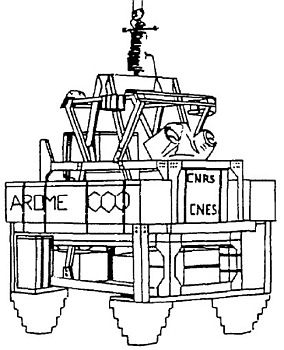Purpose of the flight and payload description
AROME was a balloon-borne astronomical instrument specifically designed for the detection of near infrared emission bands from extended sources of low surface brightness with an angular resolution of 0.5 degrees. The name of the experiment came from the polycyclic aromatic hydrocarbons (PAHs) that are present in the interstellar medium and are the origin of the 3.3 micron feature in diffuse galactic emission.
It was composed by two small ambient temperature Cassegrain telescopes of 15 cm diameter with cryogenic focussing optics and detectors, cooled at the liquid nitrogen temperature. At the flight level the nitrogen is solid at a temperature of 60 K, which is suitable for the InSb photodiodes. To avoid variations in the air mass, the elevation is kept constant. The sources are detected using a slow azimuthal scanning motion and oscillating secondary mirrors. No spectroscopy is performed, the emission band is detected by the simple comparison of the fluxes measured in a narrow and a wide photometric band, both centered on the feature's wavelength. These two bands are obtained by the splitting of each telescope's beam on an interference filter. The same set of photometric bands is obtained on the two telescopes.
The whole system, telescopes and dewar, is rotated around a vertical axis so that the field of view is scanning the sky at a constant elevation. Scans have an amplitude of 8º and a one degree per second rate. This rotation is controlled by a stepping motor and the angle is measured with a 13 bit encoder.
In the figure at left can be seen th gondola on which the receiver instrumentation subsystem, the electronics and the housekeeping (telemetry, remote command, etc) are installed. The in-flight gondola configuration has a total mass of 850 kg and a size of about 2.40 x 2.40 x 3.80 meters and counts with an azimuthal stabilization system.
Details of the balloon flight
Balloon launched on: 6/27/1990
Launch site: Base di Lancio Luigi Broglio, Trapani, Sicily, Italy
Balloon launched by: Centre National d'Etudes Spatiales (CNES)
Balloon manufacturer/size/composition: Zero Pressure Balloon Zodiac - 400.000 m3
End of flight (L for landing time, W for last contact, otherwise termination time): 6/27/1990
Balloon flight duration (F: time at float only, otherwise total flight time in d:days / h:hours or m:minutes - ): 1 h 19 m
Landing site: Balloon burst at 22 km. Payload recovered from sea the next day.
Campaign: ODISSEA 90
Payload weight: 1010 kg
Gondola weight: 694 kg
Unfortunately, the balloon met with a layer of high temperature at 22 km of altitude and burst open. The 900-kg payload was supported by a parachute and landed in the sea where it was retrieved unharmed the next day.
External references
- Large Heavy Duty Balloons in Europe 10th ESA Symposium on European Rocket and Balloon Programmes and Related Research, Pag. 287
- Stratospheric Balloon Campaign in European Science Notes Information Bulletin, March 1991, Pag. 49
13766If you consider this website interesting or useful, you can help me to keep it up and running with a small donation to cover the operational costs. Just the equivalent of the price of a cup of coffee helps a lot.


